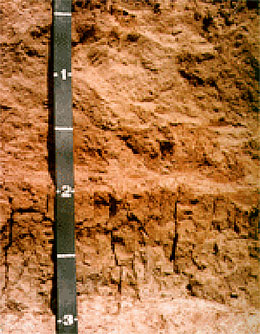- Home
- Learn about salinity
- Get to know your site
- Design a landscape
- Solve a problem
- Other information
Salinity Management Guide
Managing soil salinity
Management option: Improve internal drainage

Figure 14. Soil profile representing the San Joaquin soil series. Note clay pan at the 3-foot soil depth (PSSAC, 1997)
Managing soil salinity requires drainage throughout the soil profile (known as internal drainage) adequate to displace excess soil salinity. Impediments to adequate drainage include impermeable soil layers, such as clay pans and hardpans, and compaction of the soil by human foot traffic or by vehicular traffic. Traffic-induced problems are especially pronounced for wet soil. Figure 14 shows the upper three feet of a soil profile representing the San Joaquin soil series (PSSAC, 1997), with a cemented hardpan in the subsoil that would restrict drainage.
To improve a soil's drainage, clay pans and hardpans sometimes can be broken up, or "ripped," by chisel plowing. Another management option for compacted soils is to redirect all human and vehicular traffic away from wet areas. Yet another involves mechanical soil coring, to improve soil aeration and infiltration rates.
Waterlogging of the root zone as a result of shallow groundwater can also cause drainage problems, as well as salinity problems, if the ground water is of high salinity. Installation of subsurface drainage pipes often can alleviate waterlogging and, where groundwater is saline, reduce soil salinity. There is, however, a need to dispose of the collected subsurface drainage water in a suitable drainage channel.
| « Previous page | Next page » |